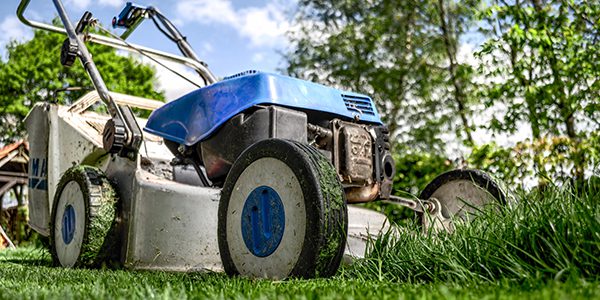How to Store a Lawnmower: 10 Important Steps

Lawnmower Storage
Your lawnmower gets a ton of use in the spring and summer months, but when fall and winter hit, it’s time to put it into hibernation. With something as well-used and essential as a lawnmower, you want to take a bit more time to properly store it than you would with other, less used outdoor equipment. Preparing a lawnmower for longterm winter storage is surprisingly similar to preparing a car for storage. You want to pay attention to the gas, oil, and exterior and make sure they are all set for storage. Improperly storing your lawnmower can lead to rust, cracking and breaking parts, and in the worst-case scenario – a completely unusable lawnmower. Follow these 10 steps to properly store your lawnmower for the winter.
Remove the Battery
If your lawnmower has a battery, remove it and bring it indoors for the winter. Make sure to store it in a cool, dry location far away from anything that produces heat. Clean the battery terminal with a metal brush, then coat all terminals with a protector. At the end of the season when you are ready to use your lawnmower again, use a battery charger to bring it back to full capacity before placing it back in your mower.
Disconnect the Spark Plug
Before doing any maintenance on your lawnmower, make sure to disconnect the spark plug. This prevents the lawnmower from starting up on accident and potentially causing major harm.
Remove and Sharpen Blade
Take the time to carefully remove the blade of your lawnmower. Make sure to wear thick gloves that protect your hands. Inspect your lawnmower blade, looking for things like rust or cracks. If the blade is cracked, you should look into replacing it for next season. After inspection, if the blade looks okay, either sharpen it yourself or take it to get sharpened. Once done, use a blade balance. A blade that is out of balance does not cut grass well and may end up damaging your engine.
Clean Your Mower Deck
While the blade of your mower is removed, take the opportunity to scrape off any grass, dirt, or other debris that is stuck to the bottom of the mower deck. Use a metal brush or putty knife to fully clean the underside of your lawnmower. If you spray down your mower to help with the cleaning process, make sure to fully dry it. Anything that is left wet, especially when storing long term, can lead to rust or mold. Once you are satisfied, spray the bottom of your lawnmower with a corrosion protection product.
Replace Air Filter
There are two different types of air filters that are used in lawnmowers: paper or foam. If you have a paper filter, you will need to throw it out and replace it with a new one. Foam filters do not need to be replaced, as they can be easily cleaned and placed back into the lawnmower. For your foam filter, wash it with soap and warm water. Once it’s dry, soak it fresh oil and squeeze it out so that it is moist, but not dripping.
Add Fuel Stabilizer
You may read in some places that you should fully drain the fuel tank of your lawnmower, but that is never advised. It’s virtually impossible to get all fuel out of your lawnmower, even if you follow the proper steps. Once empty, the tank is susceptible to oxygen, which will target whatever fuel is left and cause damage to your lawnmower. An empty tank is also dangerous because it allows water vapor to collect and cause corrosion in multiple places in your lawnmower. The materials in your fuel system may also dry out and become brittle if left dry for too long.
Instead of emptying out your fuel tank, all you have to do is add a fuel stabilizer to your gas. Add stabilizer extends the life of your fuel from 30 days to about 24 months. Keeping a full tank of gas helps prevent condensation in your gas tank, which leads to rust and corrosion. Once you’ve added the proper fuel stabilizer, run your lawnmower for a few minutes to circulate the new stabilizer through the entire fuel system.
Drain and Replace Oil
Similar to draining gas from a lawnmower, you may also read that you should fully drain the oil from your mower. For very similar reasons, this is not the case. Instead, it is advised that you fully drain the oil and replace it with fresh oil. To drain to oil, run the engine to warm it up and expel the old oil and the contaminants it contains. Replace the oil with whatever is recommended in the owner’s manual of your lawnmower.
Protect Your Engine
If you are storing your lawnmower long term, the engine oil will eventually begin to drain away and leave the internal components exposed. To prevent this, treat your engine with fogging oil before placing it in storage.
Check Drive Belts
Check your drive belts to see if they are loose, worn, or cracked. Loose belts can be tightened, while worn or cracked belts should be fully replaced.
Store in a Cool, Dry Place
Once you’ve gone through all of the effort to prepare your lawnmower for winter, you’ll want to make sure to store it properly. When storing a lawnmower, you want to pick somewhere that does not experience large changes in temperature, as that can cause condensation to occur. Most importantly, the space needs to be dry, as any moisture will cause rust and completely damage your lawnmower. Many people turn to climate-controlled storage units as the solution to storing a lawnmower. Climate-controlled units maintain a consistent temperature and humidity year-round and protect your lawnmower from the elements.
After your lawnmower is placed in the proper storage unit, you are good to go until springtime. While it may seem like a lot of work, it’s absolutely crucial to properly prepare your lawnmower for storage. It will save you time, headache, and lots of money down the road. For more important storage tips, sign up for our monthly blog newsletter.




